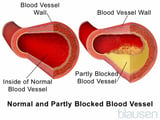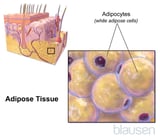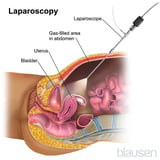I Have Pcos Why Would I Be Bleeding Again
Polycystic ovary syndrome is characterized by slight obesity, irregular or no menstrual periods, and symptoms caused by high levels of male hormones (androgens). It involves disruption of the menstrual cycle and a tendency to have loftier levels of male hormones (androgens).
-
Typically, women are obese and develop acne and masculine characteristics—the voice deepens, breast size decreases, and excess torso hair appears.
-
Doctors often base the diagnosis on symptoms, merely blood tests to measure hormone levels and ultrasonography may too exist done.
-
Practice, weight loss, and estrogen plus a progestin or progesterone or a progestin alone may help reduce symptoms (including excess trunk pilus) and restore hormone levels to normal.
-
If women wish to become pregnant, losing weight and taking clomiphene, sometimes with metformin, may stimulate release of an egg.
Polycystic ovary syndrome affects virtually five to x% of women. In the United States, it is the most common cause of infertility.
This syndrome gets its proper noun from the many fluid-filled sacs (cysts) that frequently develop in the ovaries, causing them to enlarge.
In many women with polycystic ovary syndrome, the trunk's cells resist the furnishings of insulin (called insulin resistance or sometimes prediabetes). Insulin helps sugar (glucose) pass into cells so that they can use it for energy. When cells resist its effects, saccharide accumulates in the blood, and the pancreas produces more than insulin to try to lower sugar levels in the blood. If insulin resistance becomes moderate or severe, diabetes is diagnosed.
What causes polycystic ovary syndrome is not clear. Some evidence suggests that the enzyme controlling the production of male hormones malfunctions. As a result, the production of male hormones (androgens) increases.
High levels of male hormones increase the chance of metabolic syndrome Metabolic Syndrome Metabolic syndrome is characterized by a big waist circumference (due to backlog abdominal fat), high blood pressure level, resistance to the effects of insulin (insulin resistance) or diabetes,... read more than (with high blood force per unit area, high cholesterol levels, and resistance to the effects of insulin). If male hormone levels remain high, the risk of diabetes, center and blood vessel disorders (including atherosclerosis Atherosclerosis Atherosclerosis is a condition in which patchy deposits of fatty material (atheromas or atherosclerotic plaques) develop in the walls of medium-sized and large arteries, leading to reduced or... read more  and coronary artery affliction Overview of Coronary Avenue Disease (CAD) Coronary artery disease is a condition in which the claret supply to the heart muscle is partially or completely blocked. The heart musculus needs a constant supply of oxygen-rich blood. The coronary... read more
and coronary artery affliction Overview of Coronary Avenue Disease (CAD) Coronary artery disease is a condition in which the claret supply to the heart muscle is partially or completely blocked. The heart musculus needs a constant supply of oxygen-rich blood. The coronary... read more  ), and high blood pressure is increased. Also, some of the male hormones may be converted to estrogen, increasing estrogen levels. Non plenty progesterone is produced to balance the increased level of estrogen. If this situation continues a long time, the lining of the uterus (endometrium) may go extremely thick (a status called endometrial hyperplasia). Also, the take a chance of cancer of the lining of the uterus Cancer of the Uterus Cancer of the uterus develops in the lining of the uterus (endometrium) and is thus also called endometrial cancer. Endometrial cancer commonly affects women after menopause. It sometimes causes... read more than
), and high blood pressure is increased. Also, some of the male hormones may be converted to estrogen, increasing estrogen levels. Non plenty progesterone is produced to balance the increased level of estrogen. If this situation continues a long time, the lining of the uterus (endometrium) may go extremely thick (a status called endometrial hyperplasia). Also, the take a chance of cancer of the lining of the uterus Cancer of the Uterus Cancer of the uterus develops in the lining of the uterus (endometrium) and is thus also called endometrial cancer. Endometrial cancer commonly affects women after menopause. It sometimes causes... read more than  (endometrial cancer) may be increased.
(endometrial cancer) may be increased.
Polycystic ovary syndrome may also increment the hazard of nonalcoholic fat liver affliction Fatty Liver (aberrant accumulation of fats inside liver cells that is not related to alcohol consumption).
Symptoms of polycystic ovary syndrome typically develop during puberty and worsen with time. Symptoms vary from woman to woman.
Typically, menstrual periods do non start at puberty, and the ovaries do not release an egg (that is, women do non ovulate) or release an egg irregularly. Women accept irregular vaginal bleeding or no menstrual periods.
Women as well develop symptoms related to the high levels of male person hormones—called masculinization or virilization. Symptoms include acne, a deepened phonation, a subtract in chest size, and an increase in muscle size and in body hair (hirsutism). Hair grows as it does in men (for instance, on the breast and face up) and may thin at the temples.
Most women with polycystic ovary syndrome are slightly obese, but some are thin. Producing too much insulin contributes to weight gain and makes losing weight difficult. Excess insulin due to insulin resistance may likewise cause skin in the armpits, on the nape of the cervix, and in skinfolds to become dark and thick (a disorder called acanthosis nigricans).
-
A physician's evaluation
-
Measurement of hormone levels
-
Ultrasonography
Often, the diagnosis of polycystic ovary syndrome is based on symptoms.
A pregnancy test is routinely done. Blood tests to mensurate levels of hormones such as follicle-stimulating hormone and male hormones are also done.
Ultrasonography is done to run across whether the ovaries contain many cysts and to cheque for a tumor in an ovary or adrenal gland. These tumors tin can produce excess male hormones and thus cause the same symptoms as polycystic ovary syndrome. Transvaginal ultrasonography may exist done to check for abnormalities in the ovaries. Transvaginal ultrasonography involves using a small handheld device inserted through the vagina to view the interior of the uterus.
In women with this syndrome, doctors measure blood pressure level and usually levels of blood sugar and fats (lipids), such equally cholesterol, to check for metabolic syndrome, which increases the risk of coronary artery illness.
Doctors may also practise imaging tests to check for bear witness of coronary artery disease. Imaging tests include coronary angiography (x-rays of arteries taken later a radiopaque contrast agent, which can be seen on x-rays, is injected into an artery) and computed tomography (CT) angiography (2- and 3-dimensional images of claret vessels taken after a radiopaque contrast agent is injected into a vein).
Often, a biopsy of the uterine lining (endometrial biopsy) is done to make sure no cancer is present, particularly if women take aberrant vaginal bleeding.
-
Exercise, dietary changes, and weight loss
-
Drugs, such as birth control pills, metformin, or spironolactone
-
Treatment of excess body pilus and acne
The choice of treatment for polycystic ovary syndrome depends on the following:
-
Blazon and severity of symptoms
-
The adult female's age
-
Her plans regarding pregnancy
If insulin levels are high, lowering them may assist. Exercising (at least xxx minutes a day) and reducing consumption of carbohydrates (in breads, pasta, potatoes, and sweets) can help lower insulin levels.
Weight loss may help with the post-obit:
-
Lowering insulin levels enough that ovulation tin brainstorm
-
Increasing the chances of becoming pregnant
-
Making menstrual periods more regular
-
Reducing hair growth and the risk of thickening of the uterine lining
However, weight loss is unlikely to benefit normal-weight women with polycystic ovary syndrome.
Women who practice not wish to become pregnant are usually given a birth control pill that contains only a progestin (a synthetic form of the female person hormone progesterone ), such as medroxyprogesterone, or one that contains estrogen and a progestin (a combination oral contraceptive). Either treatment may
-
Reduce the risk of endometrial cancer due to the high estrogen level
-
Make menstrual periods more regular
-
Help lower the levels of male person hormones
-
Slightly reduce excess body hair and acne
Metformin, which is used to treat type 2 diabetes, may be used to increase sensitivity to insulin so the body does not have to make as much insulin. This drug may help women lose weight, and ovulation and menstrual periods may resume. If women take metformin and do not wish to get pregnant, they should use nativity control. Metformin has little or no upshot on excess hair growth, acne, or infertility. When metformin is used, women need to periodically take claret tests to measure glucose (sugar) and to evaluate kidney and liver function.
Newer drugs that can help women with polycystic ovary syndrome lose weight include liraglutide (used to treat type 2 diabetes) and orlistat Drugs  (used to care for obesity). Orlistat and inositols (which make insulin act more finer) may reduce symptoms related to the high levels of male person hormones (such as excess torso hair) and lessen insulin resistance.
(used to care for obesity). Orlistat and inositols (which make insulin act more finer) may reduce symptoms related to the high levels of male person hormones (such as excess torso hair) and lessen insulin resistance.
If women wish to become meaning, losing weight may help. If it does not, clomiphene (a fertility drug) or letrozole is tried. These drugs stimulate ovulation. If these drugs are ineffective and the woman has insulin resistance, metformin may aid because lowering insulin levels may trigger ovulation. If none of these drugs is effective, other fertility drugs may be tried. They include follicle-stimulating hormone (to stimulate the ovaries), a gonadotropin-releasing hormone (GnRH) agonists Drugs used to treat endometriosis  (to stimulate the release of follicle-stimulating hormone), and human chorionic gonadotropin (to trigger ovulation).
(to stimulate the release of follicle-stimulating hormone), and human chorionic gonadotropin (to trigger ovulation).
If fertility drugs are ineffective or if women practice not wish to take them, surgery (called ovarian drilling) may be tried. It is washed past laparoscopy. Doctors make smalls incisions but to a higher place or below the navel. They then insert a thin viewing tube (called a laparoscope) into the abdominal crenel through one incision. Through another incision, they insert special tools that use an electric current or laser to destroy small-scale areas of the ovaries that produce male person hormones (androgens). Thus, androgen product is decreased. Decreasing the high levels of androgens in women with polycystic ovary syndrome can aid regulate menstrual cycles and improve the chances of pregnancy. General anesthesia is required.
-
Eflornithine cream may assist remove unwanted facial pilus.
-
Oral contraceptives may help, but they must be taken for several months before any outcome, which is frequently slight, can be seen.
-
Spironolactone, a drug that blocks the production and activity of male hormones, can reduce the amount of unwanted body hair. Side effects include increased urine production and depression claret pressure (sometimes causing fainting). Spironolactone may not exist rubber for a developing fetus, so sexually active women taking the drug are advised to utilise effective nascence control methods.
-
Cyproterone, a strong progestin that blocks the action of male hormones, reduces the corporeality of unwanted torso hair in 50 to 75% of affected women. It is used in many countries but is not approved in the United States.
Gonadotropin-releasing hormone agonists and antagonists are being studied as treatment for unwanted body hair. Both types of drugs inhibit the production of sex hormones by the ovaries. Simply both can cause os loss and lead to osteoporosis.
Losing weight reduces production of androgens and thus may irksome hair growth.
mccloskeysibes2000.blogspot.com
Source: https://www.msdmanuals.com/home/women-s-health-issues/menstrual-disorders-and-abnormal-vaginal-bleeding/polycystic-ovary-syndrome-pcos



Post a Comment for "I Have Pcos Why Would I Be Bleeding Again"